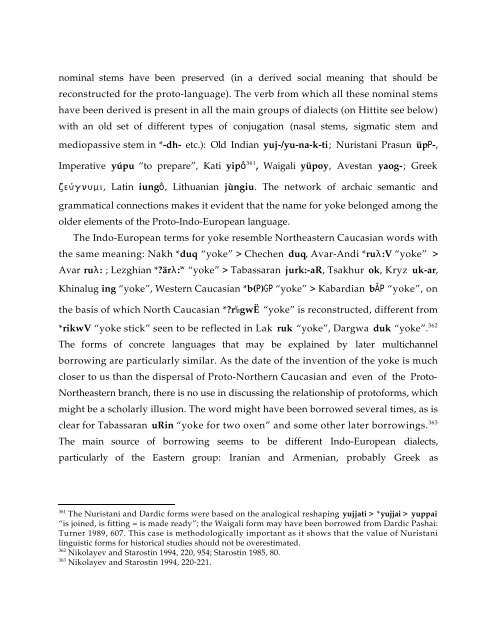Comparative Notes on Hurro-Urartian, Northern Caucasian
Comparative Notes on Hurro-Urartian, Northern Caucasian
Comparative Notes on Hurro-Urartian, Northern Caucasian
Create successful ePaper yourself
Turn your PDF publications into a flip-book with our unique Google optimized e-Paper software.
nominal stems have been preserved (in a derived social meaning that should be<br />
rec<strong>on</strong>structed for the proto-language). The verb from which all these nominal stems<br />
have been derived is present in all the main groups of dialects (<strong>on</strong> Hittite see below)<br />
with an old set of different types of c<strong>on</strong>jugati<strong>on</strong> (nasal stems, sigmatic stem and<br />
mediopassive stem in *-dh- etc.): Old Indian yuj-/yu-na-k-ti; Nuristani Prasun üpP-,<br />
Imperative yúpu “to prepare”, Kati yipô 361 , Waigali yüpoy, Avestan yaog-; Greek<br />
zeÊgnumi, Latin iungô, Lithuanian jùngiu. The network of archaic semantic and<br />
grammatical c<strong>on</strong>necti<strong>on</strong>s makes it evident that the name for yoke bel<strong>on</strong>ged am<strong>on</strong>g the<br />
older elements of the Proto-Indo-European language.<br />
The Indo-European terms for yoke resemble Northeastern <strong>Caucasian</strong> words with<br />
the same meaning: Nakh *duq “yoke” > Chechen duq, Avar-Andi *rul:V “yoke” ><br />
Avar rul: ; Lezghian *?ärl: w “yoke” > Tabassaran jurk:-aR, Tsakhur ok, Kryz uk-ar,<br />
Khinalug ing “yoke”, Western <strong>Caucasian</strong> *b(P)GP “yoke” > Kabardian bÃP “yoke”, <strong>on</strong><br />
the basis of which North <strong>Caucasian</strong> *?r‰gwË “yoke” is rec<strong>on</strong>structed, different from<br />
*rikwV “yoke stick” seen to be reflected in Lak ruk “yoke”, Dargwa duk “yoke”. 362<br />
The forms of c<strong>on</strong>crete languages that may be explained by later multichannel<br />
borrowing are particularly similar. As the date of the inventi<strong>on</strong> of the yoke is much<br />
closer to us than the dispersal of Proto-<strong>Northern</strong> <strong>Caucasian</strong> and even of the Proto-<br />
Northeastern branch, there is no use in discussing the relati<strong>on</strong>ship of protoforms, which<br />
might be a scholarly illusi<strong>on</strong>. The word might have been borrowed several times, as is<br />
clear for Tabassaran uRin “yoke for two oxen” and some other later borrowings. 363<br />
The main source of borrowing seems to be different Indo-European dialects,<br />
particularly of the Eastern group: Iranian and Armenian, probably Greek as<br />
361 The Nuristani and Dardic forms were based <strong>on</strong> the analogical reshaping yujjati > *yujjai > yuppai<br />
“is joined, is fitting = is made ready”; the Waigali form may have been borrowed from Dardic Pashai:<br />
Turner 1989, 607. This case is methodologically important as it shows that the value of Nuristani<br />
linguistic forms for historical studies should not be overestimated.<br />
362 Nikolayev and Starostin 1994, 220, 954; Starostin 1985, 80.<br />
363 Nikolayev and Starostin 1994, 220-221.





